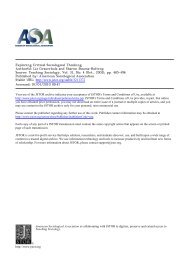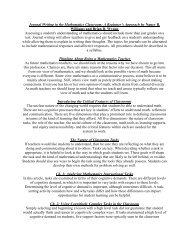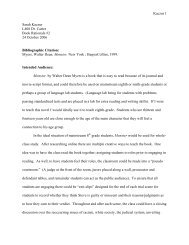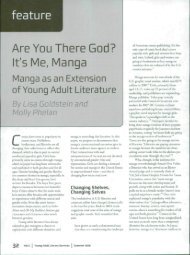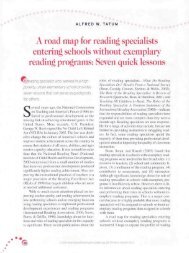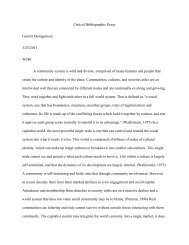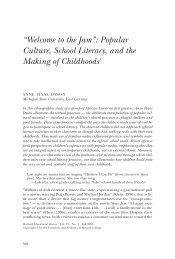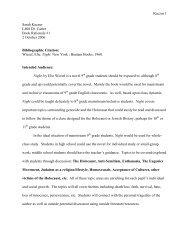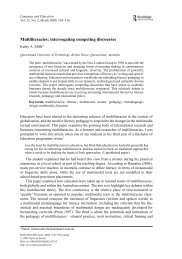Rose 2005 Pragmatics Synthesis.pdf - Oncourse
Rose 2005 Pragmatics Synthesis.pdf - Oncourse
Rose 2005 Pragmatics Synthesis.pdf - Oncourse
Create successful ePaper yourself
Turn your PDF publications into a flip-book with our unique Google optimized e-Paper software.
392 K.R. <strong>Rose</strong> / System 33 (<strong>2005</strong>) 385–399<br />
Overall, however, the research provides ample evidence demonstrating the teachability<br />
of pragmatic features. But is instruction more effective than simple exposure<br />
4.2. Instruction versus exposure<br />
Instruction versus exposure studies address the issue of whether pedagogical intervention<br />
in pragmatics leads to more effective learning than no instruction, or put another<br />
way, whether instruction is better than simple exposure. These studies provide<br />
a direct means of testing SchmidtÕs (1993) noticing hypothesis: the extent to which<br />
instruction which serves to draw learnersÕ attention to the targeted features proves<br />
to be more beneficial than simple exposure to the target language is the degree to<br />
which the noticing hypothesis is supported. As with the previous group of studies,<br />
instruction in each of the studies in this group could be characterized as explicit.<br />
A wide range of learning targets is represented in this group. BillmyerÕs (1990a,b)<br />
study on the effects of instruction on compliments and compliment responses was<br />
among the earliest interventional studies. Bouton (1994a) selected the understanding<br />
of implicature as his learning target, while Lyster (1994) examined the use of French<br />
tu/vous in informal and formal contexts. Wishnoff (2000) investigated the effects of<br />
instruction in the use of hedging devices (e.g., verb choice, quantifiers, modifiers,<br />
and conditional statements) in both formal and informal texts, and YoshimiÕs<br />
(2001) study focused on the Japanese interactional markers (n desu, n desu kedo, n<br />
desu ne) which feature prominently in the production of oral narratives. The range<br />
of instructional periods is also rather wide, with WishnoffÕs two class sessions (a total<br />
of one-and-a-half hours) on one end, and YoshimiÕs 24 h of instruction spread over<br />
an entire semester at the other. Assessment procedures included multiple choice tests<br />
(Bouton, 1994a; Lyster, 1994), and production tasks that were oral (Lyster, 1994)<br />
and written (Lyster, 1994; Wishnoff, 2000; Yoshimi, 2001). Only Billmyer<br />
(1990a,b) used as a measure of instructional effects learner production in actual<br />
face-to-face interaction. It is also worth noting that only Lyster (1994) employed<br />
more than one outcome measure.<br />
Without exception, learners receiving instruction in pragmatics outperformed those<br />
who did not. BillmyerÕs (1990a,b) instructed group outperformed the controls for frequency<br />
of compliments, norm-appropriate use, spontaneity, and adjectival repertoire,<br />
and favored the response strategy of deflection as they were taught, while the control<br />
group favored acceptance. In BoutonÕs (1994a) study, the experimental group achieved<br />
results as high as those observed with previous immersion students who had spent four<br />
years living in the US, but there was no such improvement for the control group.<br />
LysterÕs (1994) experimental participants outperformed uninstructed learners on all<br />
tasks except informal oral production, for which all learners used tu appropriately.<br />
These differences remained at the time of the delayed posttest. In the case of Wishnoff<br />
(2000), while use of hedges increased for both groups, the treatment groupÕs hedging<br />
devices increased more than 5-fold – a statistically significant difference across groups.<br />
And YoshimiÕs (2001) instructed learners showed a dramatic increase in frequency of<br />
interactional markers, but no similar increase in their use by the control group was observed.<br />
Although in these studies instruction proved superior to exposure, exposure



